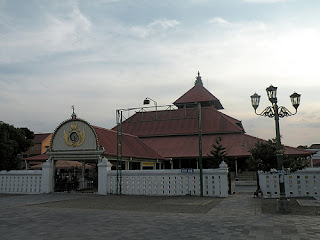
The north town square or in the Java language is called Alun-alun Lor is one of the Yogyakarta city land mark in the form of a terrain located in front of the Sultan Palace. Called Northern Square because in the city of Yogyakarta there are two square that is located in the south and north of Yogyakarta Palace. The northern square-shaped square with an area of 150 x 150 meters with two large banyan trees fenced in the middle of the square. Two Big Banyan Trees were each given a name and Kyai Kyai Dewandaru Wijayandaru. In the past around the North town square planted 63 of banyan tree that symbolizes life of Prophet Muhammad.
The Northern Square in the Past
Some sources say that the first surface of the square is a fine sand suitable for the training of the soldiers also to show prowess in front of the Sultan. Sultan and the royal princes in the Siti Hinggil sit, that is the face of the palace that has a higher surface to see the attraction of its soldiers. Alun-alun Lor is also used for "Tapas Pepe ', a form of performance out of people's voices to be heard and the attention of the sultan. Tapas Pepe done in the afternoon heat between two banyan tree by a man who was pleading for justice directly to the Sultan.
In ancient times, Alun-alun Lor is a sacred territory in which not just anyone is allowed to enter it. There are rules that must be obeyed if you want to enter, for example, may not use vehicles, shoes, slippers, cane, and develop an umbrella. This is done as a form of homage to the King Palace Ngayogyakarta.
Northern Square as Public Space
Unlike today, Northern Square (Alun-alun Lor) became a public space that can be used by everyone. Here you can find a variety of vendors around the square from morning until night. At certain times, such as the Fair Sekaten, Grebeg Maulud Celebration of the Prophet, and the other palace ceremonies, Alun-alun Lor to manifest as a place that is bustling and crowded with many people because these events are always held in this square. Another regular event held here this is a cultural art performances, music concerts, fairs, bicycle relaxed, and other activities.
 |
| Grebeg ceremonial |
Sekaten celebration
In Yogyakarta there is a culture that until now still continue to be preserved is Sekaten. Organized to commemorate the birth of Prophet Muhammad who was born on 12 Maulud or Mulud in the third month in Java. Held on the date of 6 to 12 in the same month. Celebrations sekaten include "Sekaten Sepisan" and closed with "Grebeg" on page Great Mosque of Yogyakarta or often referred to as Mosque Gedhe Kauman. Sekaten is a symbol of togetherness that is identified with the palace and its people.
Sekaten taken from the spoken word sentence "Creed". Terms Creed, which is pronounced as Syahadatain is then gradually changed in pronunciation, making it Syakatain and eventually became the term "Sekaten" until now. But in their origins than syahadatain, said sekaten also taken from some other word.
 |
| sekaten |
 |
| The Sekaten's Night Market |
Travel to the Northern Town Square is very easy because it is situated in the center of Yogyakarta city with easy access to get there. If you're from the st. Malioboro, then go straight to the south past the intersection zero kilo meters. The distance from the intersection of zero kilo meters to the Northern Town Square is about 100 meters. Visiting the Northern Square , a time also to visit the sights around him: Sultan Palace, Mosque Gedhe, Wijilan Gudeg centers, tourist centers Malioboro, as well as Fort Vredeburg.
 | |
| Sultan Palace |
 |
| Mosque Gedhe |
 |
| Traditional food called Gudeg |
 |
| Wijilan gudeg centers |
 |
| Malioboro tourist centers |
 |
| Fort Vredeburg |



No comments:
Post a Comment